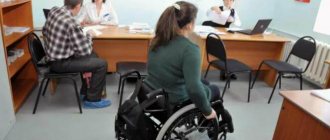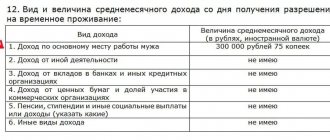MSE or medical and social examination exists to perform certain tasks, in particular, conducting an examination, assigning a disability group, assessing the current state of health and further forecasts.
ITU experts must determine the need of a potential disabled person for social protection and rehabilitation, based on the criteria approved in Art. 7 and 8 Federal Law No. 181 of November 24, 1995 “On the social protection of disabled people in the Russian Federation.”
This law also characterizes the ITU examination as a process of assigning an appropriate status to the applicant, taking into account the degree of disability and more. Next, we answer the most pressing questions within the topic.
The concept of medical and social examination
Medical and social examination is a procedure for examining citizens to determine the degree of their disability. The ITU first appeared in Russia in 1919 and was called the Medical Control Commission (MCC), in 1929 additional functions were added to its main functions, and the composition was renamed the Medical Labor Expert Commission (VTEK).
If initially the task of recognizing a person’s inability to continue working activity fell on the shoulders of the VKK, now the service identified the factors that influenced irreversible changes in the citizen’s health, and also determined the prospects for the further course of the disease. With the effect of Federal Law No. 181-FZ, VTEK were renamed into the Medical and Social Expert Commission (MSEC).
Judicial ITU
The specific concept is not enshrined in law, however, on the basis of Article 9 of Federal Law No. 73 of May 31, 2011 and Art. 7 No. 181 Federal Law of November 24, 1995, we can conclude that forensic medical and social examination is usually called the determination of a person’s need for social protection measures.
In judicial practice, medical and social examination is divided into:
- Examination of case materials;
- Expertise on living people.
The purposes of appointing an expert examination during legal proceedings:
- determine the exact state of a person at a given moment in time;
- understand the causes of this condition;
- decide to punish those responsible.
It is appointed by a court ruling or a resolution of an investigator or inquiry officer.
Judicial ITU reveals:
- diseases on the basis of which a disability group is assigned;
- degree of disability;
- the cause of death of a disabled person to provide the relatives of the deceased with social support;
- need for social and professional rehabilitation;
- need for medical care, rehabilitation and medication.
After the examination, the expert issues a conclusion, which will be the basis for further legal proceedings.
Tasks and functions of ITU
If we describe the work carried out within the walls of the ITU in two words, it would be the phrase “medical examination for disability” with all the accompanying aspects.
The common objectives for the entire ITU system of bodies are:
- The beginning of working with the visitor is to analyze the factors that caused the loss (full or partial) of performance. Is this the result of an injury, or a natural result of a long-term chronic disease, and other reasons.
- Determination of the degree of loss of performance as a percentage. Based on this, a disability group is established. This factor is determined not by one doctor, but by an expert commission.
- If necessary, rehabilitation measures are individually developed and a treatment plan is drawn up, the purpose of which is the most painless and rapid integration of the disabled person into society, including psychological assistance. There are now many social and medical programs carried out by both government agencies and private ones.
- A persistent loss of working capacity (total disability) is determined, which does not imply the effect of rehabilitation measures.
- If it is impossible to take care of oneself independently, and there are no close relatives who agree to help the disabled person with this, he gives a conclusion on the need to establish patronage over him.
- Conducts educational and preventive work both among people with disabilities and at enterprises and organizations among workers, aimed at preventing accidents and work-related injuries.
- As part of cooperation with military commissions, it regularly provides information about citizens of military age who have received a disability group.
- Conducts analytical work, statistical observation of all citizens who applied for examination in the entrusted territory, maintaining relevant statistics.
There are a lot of functions, and this is the reason why a lot of requirements are placed on the employees of these bodies. This concerns not only and not so much the level of professional (medical) skill, but also moral qualities. Public opinion on this issue, which is close to everyone, regarding the assignment of disability, is not always favorable to the employees of these organizations.
Purpose
The main purpose of this government structure is to provide people in need with the legal status of “disabled” in order to ensure their access to government support measures, allocated quotas and other services. In addition, the state, with the help of ITU, creates conditions that would be closer to the living standards of healthy citizens .
Attention! To apply to ITU, a person must have a special form No. 088/u-06 on hand. In the event of a written refusal to complete it by the authorized bodies, the person has the right to apply for examination independently.
.
By the way, such a referral is issued only by medical institutions, pension funds and social security authorities, clause 19 of the Rules.
Activities and tasks
The activities of the bureau as a whole are aimed at implementing programs for the protection of persons with disabilities, which is expressed in exemption from production work or the provision of social guarantees that will provide material support when transferring an employee to an easier and less strenuous type of work.
This would sharply reduce the income of a disabled person, without government support.
ITU distributes citizens applying for disability into disability groups. Here they are differentiated by age and professional affiliation. Persons under the age of majority are assigned the category of disabled child.
Reaching the age of majority requires re-examination and re-registration of a person’s disability. The status of a disabled child changes to disabled from childhood.
Certified law enforcement officers and persons equivalent to them are rehabilitated under special programs.
They assign disability groups , undergo a re-examination, with confirmation or removal of the disabled status.
In order to establish extremely accurate and fair matches, the bureau's experts work collectively. In higher structures, analytical work is carried out on the quantitative and qualitative composition of groups of subjects.
The Federal Bureau of ITU, as well as the bureaus of the constituent entities of the Russian Federation, monitor the effectiveness of rehabilitation prescriptions, develop additional programs and improve existing ones.
Besides:
- Advanced training courses for doctors are systematically conducted;
- theoretical achievements are broadcast;
- new forms of work are being introduced;
- new competencies are established.
The tasks solved by the bureau’s specialists include:
- Establishing interaction with local medical institutions in order to recreate the most complete picture of the development of pathology, based on the submitted medical documentation.
- Interaction with inpatient facilities to examine seriously ill patients who cannot be transported.
- Interaction with enterprises and organizations in establishing disability as a result of accidents leading to injuries.
- Interaction with pension authorities and social rehabilitation centers.
- Organization of examination activities, assignment of disability groups to citizens of various categories, removal or extension of the period of disability upon re-examination.
- Establishment and definition of sanitary labor standards that guarantee a reduction in the risk of developing pathologies.
- Development and implementation of forms and methods of rehabilitation of citizens with disabilities, in direct contact with medical and social rehabilitation centers.
- Work with documentation, checking it, processing and drawing up statements of recognition of disability.
An important element of the examination is the development of the IPRI. It is carried out at three levels:
- medical;
- social;
- professional
The listed activities are based on the criteria developed by the Ministry of Labor and Social Protection, dated September 29, 2014, No. 664n, which represent a classifier for determining the disability group.
In addition, to numerous acts, regulations and rules set out in Letters and Orders of the Ministry of Health and Social Development. They are regulated by legislative documentation and approved by the Ministry of Justice of the Russian Federation.
When establishing disability, the bureau relies on a legal precedent published back in 1996 and approved by the Government of the Russian Federation “Regulations on recognizing a person as a disabled person.” The legal guarantees it establishes are based on the laws of the Constitution, which remains relevant to this day.
All medical services provided in the ITU bureau at all levels are included in the basic government program for social security of citizens and are provided to citizens free of charge.
IPRI is a mandatory form of implementation imputed to local governments at all levels of government. Failure to comply guarantees administrative liability. All enterprises and organizations in the region should participate in it, regardless of their form of ownership.
Characteristics for MSE, be it production, child or working conditions, are filled out in accordance with the classification.
Find out about the specifics of passing the ITU for drivers and accountants, as well as how to prepare an application. If something didn’t work out during the passage, you can do it again.
Types of procedure
- Examination of temporary disability . Involves counseling the applicant regarding the loss of his professional qualities.
- Medical and social examination . Includes a qualitative assessment of the health status, ascertaining the rehabilitation potential of the applicant.
- Military medical examination . Its primary goal is to establish suitability for military service.
- Forensic-medical examination . It refers to the preparation of a medical expert’s opinion on issues of the investigative bodies.
What do ITU institutions include?
Clause 1 of the Procedure, approved by Order of the Ministry of Labor No. 310n dated October 11, 2012, indicates that the ITU hierarchical system includes:
— Federal Bureau of Medical and Social Expertise (FB MSE) is a central body that controls lower-level bureaus, if necessary, carrying out examinations (if the case is complex, special or a disabled person wants to appeal a previously made medical decision) and training specialists in this profile (including advanced training) ;
— ITU main bureaus in the regions (ITU GB) – operate within a certain subject of the country, can review conclusions issued in local bureaus and adopt new ones, assess the applicant’s health by creating a special expert panel;
— Main Bureau of the ITU FMBA (residents of certain territories and employees of certain industrial sectors with special working conditions are examined here);
- Local ITU bureaus (their number is calculated depending on the number of local population), that is, located in populated areas and representing branches - this is where any survey begins.
By the way, in addition to the above, there are bureaus in which work regarding the establishment of disability is carried out for one of the diseases (tuberculosis, visual and mental defects, etc.).
Services provided
The tasks performed by the examination are specified in Art. 8 Federal Law No. 181-FZ
These include the following services:
- Admission of children under 18 years of age with the aim of granting them the status of “disabled child”.
- Initial and secondary reception of citizens with general diseases.
- Reception of persons who have suffered a work-related injury or occupational disease.
- Identification of persons in need of regular external care.
- Finding out the true causes of disability.
- Determination of loss of ability to work for law enforcement officers, correctional authorities, etc.
- If the outcome is unfavorable, determine the causes that led to death.
Want to get a complete understanding of ITU's work? Read our other articles! From them you will learn:
- on the procedure for conducting the examination;
- on ITU classification and criteria;
- about the features of the disability commission for children;
- about the nuances of re-examination.
Existing types
The Bureau carries out multifunctional surveys, which are carried out in several areas and are divided into types:
- Establishing a child's disability on the basis of congenital defects or as a result of a long-term illness that does not lead to improvement. Installed for persons under 18 years of age.
- Examination of citizens and decision on recognition of disability based on past illnesses and the general clinical picture accompanying somatic and mental disorders.
- Rehabilitation of workers who have suffered industrial (and other) injuries.
- Determination of the disability group as a result of a chronic occupational disease.
- Repeated examination of the listed categories of persons.
- Determining the need for constant care from close relatives or persons conscripted for military service who are unable to independently carry out life activities and self-care.
- Determination of causes of disability (optional) for some categories.
- Determination of disability of employees of the Department of Internal Affairs, the Department of Internal Affairs, the Ministry of Emergency Situations, etc.
- Determination of the causes of death of a person with limited ability to live, as established by the ITU.
The most common in terms of the number of requests is the medical and social service, as a result of which disability groups are established and re-established.
However, it is accompanied by a rehabilitation program developed by specialists, which must be completed after re-examination and a positive decision on granting disabled status.
Hierarchical structure of the institution
Below we will take a closer look at the three-stage structure of the ITU:
- ITU Bureau branches. The lowest level. They are divided according to service areas of the locality and region. One expert panel per year must examine 1,800–2,000 citizens; the exact number of bureaus is established by the district administration. This leads to the conclusion that the larger the settlement, the greater the number of branches operating in it. For example, there are 95 such bureaus in Moscow.
In addition, there are highly specialized oncological, ophthalmological, tuberculosis, psychiatric and children's bureaus. The latter, by the way, accepts children from one year to eighteen years old.
- The ITU Main Bureau (hereinafter referred to as the ITU GB), to which the branches are subordinate. Carries out a control function at the regional level, and also re-examines citizens to assess the correctness of the decision made.
- Federal Bureau of the ITU (hereinafter referred to as the ITU FB). Here, the controversial decisions made by the Head Office are studied in detail. In addition, the body controls the activities of the primary authorities of the ITU. His decisions can only be overturned through the courts.
Attention! The Bureau and Main Bureau are located in the regions, the ITU Federal Bureau is located only in Moscow.
How to appeal an ITU decision?
If you disagree with the results, you can submit an application to the same bureau where the examination took place. From here, the request for appeal and a package of documents will be sent to the main bureau within 3 days. Then, within one month, a re-examination will take place.
If you are not satisfied with the decision again, you need to act according to the principle described earlier, only this time the application is sent from the main office to the federal bureau. The maximum period for making a decision here is also 30 days.
Finally, the last authority where you can express your disagreement with the opinion of the expert commission on disability is the court. By filing a claim within 3 days from the date of receipt of the ITU decision, the applicant has the right to insist on the involvement of independent specialists.
Important
: the statement of appeal (without abbreviations and abbreviations of words) must include the full name and address of the applicant, as well as the essence of his disagreement and a request to appoint a new examination.
ITU bodies
Citizens are advised by the bureaus and the Main Bureaus. The former specialize in the initial reception of citizens (at the place of registration), identifying disabling signs, determining their causes, and collecting statistical data within their service area.
If you do not want to agree with the decision, you can challenge it within 30 days by filing a complaint.
The ITU GB operates on the basis of the following standards: one bureau controls the activities of 5-6 branches. It, as we found out, coordinates the work of lower bodies.
Their tasks also include:
- changes in opinions issued by branches;
- conducting a control inspection on its own initiative in order to establish the correctness of the decision made by the branch;
- collecting statistical data on disability, consulting subordinate specialists.
A department can also be created on its basis to confirm the diagnosis, conduct additional studies, etc.
Attention! The costs associated with maintaining the bureau are reimbursed by regional authorities.
The ITU Federal Bureau can change the decisions of lower bodies , in difficult cases, examine citizens (as recommended by the Head Bureau), stimulate regular research on the recommendation of a higher body, and submit proposals for improving the work of the ITU for discussion to the Ministry.
When should the examination be carried out?
A maximum of 30 days may pass from the date of submission of the application, and the fact of registration is recorded in a special journal. During this time, according to the rules, an examination is carried out (if necessary) and an examination is carried out (by the way, the time is set in such a way that you do not have to wait in line for more than half an hour).
Most often, an invitation for examination in paper or electronic form is received by a citizen with disabilities within 5 days from the date of submission of the application and documentation (papers can not be submitted immediately, but no later than 10 calendar days, starting from the date the request was generated).
Bureau composition
It consists of three doctors of different specializations. In general, this includes: therapist, neurologist, surgeon, rehabilitation specialist, psychologist. If necessary, as we have already said, a social work specialist. In highly specialized bureaus, an oncologist, an ophthalmologist, a phthisiatrician, a psychiatrist, and a pediatrician, respectively, also participate in the examination.
The conclusion is made during an open discussion and is generally binding for execution in all instances. The result of the inspection is announced out loud in front of the citizen; if additional questions arise, specialists give the required comments.
Members of the commission are responsible for the correctness of the decision made and the disclosure of confidential information.
Attention! The third disability group is the mildest, the first group is the most severe, assigned when a citizen is completely incapacitated and does not have the ability to independently care.
Who is on the ITU Commission?
Based on clause 4 of the Procedure, approved. By Order of the Ministry of Labor No. 310n dated October 11, 2012, you can find out that the examination is carried out by specialists from a specific bureau (the one where the applicant applied). The commission should consist of three doctors and other professionals, if necessary (rehabilitation specialists, psychologists, etc.).
If the situation requires it, experts in adaptation and social work are included in the commission, and specialized specialists may be additionally invited to implement the additional examination program within the ITU.
Be that as it may, according to GOST R 55635-2013, the requirements for all participating experts are approximately the same. For example, they must have specialized education and knowledge regarding the basics of health care legislation, ITU, and the international classification of disabilities (ICF). Experience in conducting ITU (including international) will not hurt.
A specialist on the commission must be able to make a rehabilitation prognosis and assess the patient’s rehabilitation potential, as well as have ethical skills, have an understanding of safety precautions and be ready to perform the necessary functions that do not go beyond their competence.
List of documents and description of the commission’s work process
As mentioned above, the purpose of the ITU is to determine disability . For this purpose, special commissions are created, which include experienced and competent doctors. They study all the documents provided by the citizen, the results of tests, examinations, etc.
List of required documents to be analyzed:
- statement;
- direction No. 088/у-06;
- passport;
- SNILS;
- document confirming work experience;
- sick leave (if any);
- medical reports, tests, hospital discharges, etc.;
- medical card;
- certificate of disability and IPR (upon re-examination).
In order to pass the ITU, you may need other documents. Find out how to fill out an application and a mailing list, how and where to fill out a production reference, and what a pedagogical reference for a medical and social examination should contain.
Based on the data provided, a conclusion is made that equates the citizen to a certain category of persons in need of additional state assistance. After the inspection, a report is drawn up in which all members of the commission sign.
The document is certified by a seal, filed with the file and stored for 10 years. If additional tests are necessary, doctors give appropriate recommendations ; if a person refuses to carry them out, a decision is made based on the available data.
A resolution to assign a citizen the first disability group is issued for a period of 24 months, the second and third - for 12 months. The category “disabled child” is assigned based on the severity of the illness for 12, 24 months or until he reaches adulthood.
A lifelong group is assigned in the absence of positive dynamics . At the same time, whether a citizen reaches retirement age is not a determining factor in this matter.
Typically, one bureau operates in a population center of more than 90,000 people.
What tasks does the ITU bureau solve?
So, in total, 5 key tasks can be identified (some of them are briefly stated above and will be discussed):
1) Establishing disability - for this, doctors must check the compliance of the restrictions with the specified criteria, in other words, those who have persistent health problems caused by injuries, defects or diseases are considered disabled, and the ability to care for themselves is not fully manifested or lost (the same most concerns communication, doing work, etc.).
2) Development of an IPR for a disabled person (individual rehabilitation program) - we are talking about a specially developed document that contains a set of measures to compensate or restore lost abilities of the body, plus, the program may indicate the tasks and goals of the expected results with possible consequences and much more (for example , opportunity for training and work with recommendations).
3) Determination of the disability group - here we mean such categories as disability groups 1, 2 and 3 and separately “disabled child”. In any case, the key role is played by the severity of the violations, on the basis of which a specific group is assigned (for example, group 1 indicates severe restrictions).
4) Repeated examination - confirmation (extension) of disability for groups 2 and 3 is necessary every year, and for group 1 - every few years, unless, of course, the status is assigned for life. Disabled children can be examined once a year or several years until they reach adulthood, then the process is repeated and it is likely that the group will be given indefinitely (especially due to the lack of positive dynamics).
5) Identification of the causes of death of disabled people - to use this service, one of the family members of a deceased person with disabilities must write an application, attaching a package of documents (passport, copies of the death certificate and certificate of disability, an extract from the examination card of the pathologist). As a result, an expert opinion is formed (it has an electronic or paper form).
Tasks
- Conducting consultations to identify the grounds for assigning disability and providing rehabilitation equipment (wheelchair, orthopedic shoes, etc.).
- Finding out the true causes and conditions that led to the onset of disability, analyzing the clinical picture, establishing prognosis for the course of the disease.
- Creation of special programs aimed at restoring lost health, social support, and preventing disability.
- Formation of a database, study of the dynamics of disability, the causes of its occurrence.
Authority
- Send citizens for additional tests and examinations of the body necessary to determine the prognosis for the development of the disease.
- Collect data important for further work.
- Schedule a follow-up examination to determine the effectiveness of the course of treatment.
- Register and take appropriate action to respond to dissatisfaction with the work of the lower bureau.
- Supervise and advise the activities of clinics that provide referrals for medical examination.
- Organize inspections of working conditions adapted for disabled people at enterprises.







